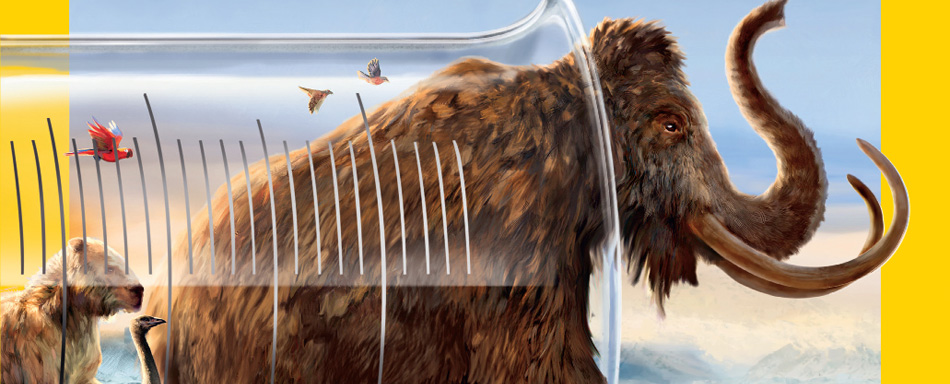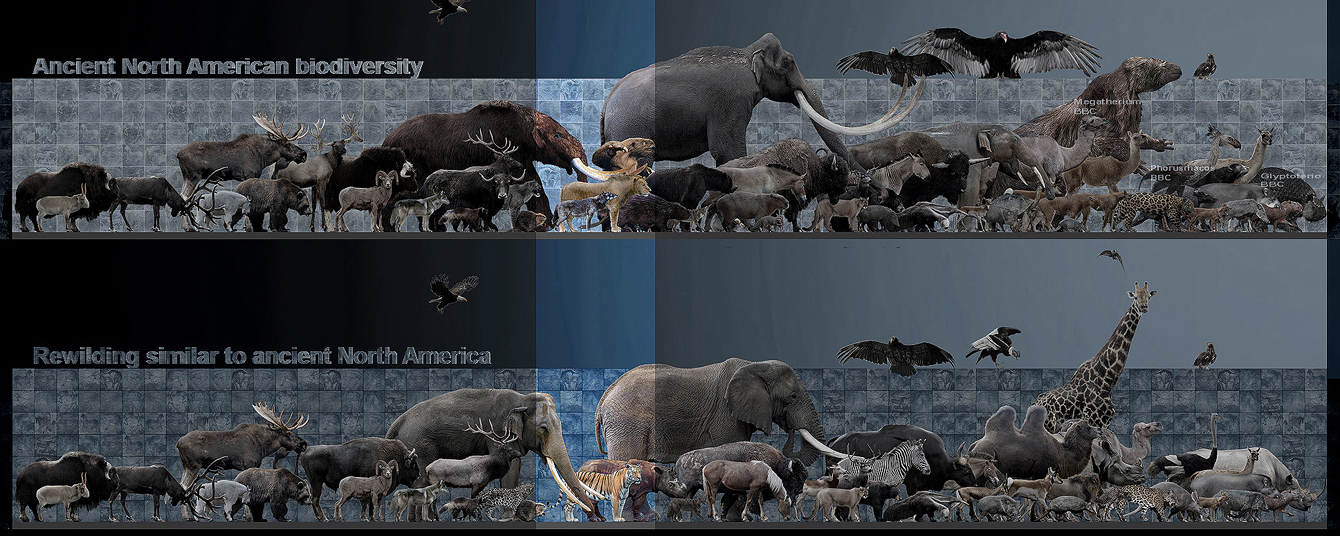


"Naysayers at their polite best chided the rewilders for romanticizing the past; at their sniping worst, for tempting a 'Jurassic Park' disaster. To these the rewilders quietly voiced a sad and stinging reply. The most dangerous experiment is already underway. The future most to be feared is the one now dictated by the status quo. In vanquishing our most fearsome beasts from the modern world, we have released worse monsters from the compound. They come in disarmingly meek and insidious forms, in chewing plagues of hoofed beasts and sweeping hordes of rats and cats and second-order predators. They come in the form of denuded seascapes and barren forests, ruled by jellyfish and urchins, killer deer and sociopathic monkeys. They come as haunting demons of the human mind. In conquering the fearsome beasts, the conquerors had unwittingly orphaned themselves." -- William Stolzenburg (2008), Where the Wild Things Were: Life, Death, and Ecological Wreckage in a Land of Vanishing Predators
BIG QUESTIONS: How can the paleontological perspective be used in service of endangered species and threatened ecosystems?
Paleontology to the Rescue? Conservation Paleobiology
A big part of the crisis, however, is that even though it is incredibly fast by geologic timescales, this is going on slower than society notices. Additionally, by the time that field ecology really got going, especially in the marine realm (the mid-20th Century), the crisis was well underway. So how do we know what is really "natural"?
That is where conservation paleobiology comes in. Largely pioneered by invertebrate paleontologist Jeremy Jackson, conservation paleobiology works by looking at the fossil record of the latest Quaternary and early Holocene to get a description of the biodiversity of the contemporary species prior to any significant influence of humans. Furthermore, more ancient crises (like PETM and mass extinction recoveries) give us evidence of how the biosphere reacts to tremendous rapid changes. This evidence from the fossil record allows conservation biologists to make better plans in dealing with current and near-future changes.
It has been noted that conservation paleobiology gives us a tremendous amount of useful data, such as:
But is extinction really the end? A few paleontologists and other scientists have suggested methods to recover ancient ecosystems, or even ancient species.
Rewilding: If a species still persists in some region, but has undergone extirpation at another, it is possible to reintroduce it. But what about cases where the extinct taxon is globally extinct? It might be possible rewild it: that is, to introduce to a habitat a closely related species with similar biology and ecology to replace the original one. These efforts are already ongoing at various sites in the world, and generally show promise (so long as unwanted introduced invasives can be eliminated, too.)
Rewilding can benefit an ecosystem by restoring links that were once present, and thus increase the biodiversity and productivity of that region. This way habitats can be reestablished where key taxa are extinct. (In particular, megafauna tend to be major architects of ecosystems.) For instance, a great number of large fruits with huge seeds (like avocados) no longer have natural dispersers. That is because the animals which DID swallow these fruit and distributed the seeds are largely extinct: various proboscideans, giant ground sloths, big marsupials, giant tortoises, etc. (depending on where you are on the planet). These are also the sorts of animals that have preferentially died out in the Pleistocene and Holocene extinctions.
A promising example of rewilding to reestablish an old link in an ecosystem is on Mauritius (a small island in the Indian Ocean, east of Madagascar). Although famous for the dodo, Mauritius had a number of other recent extinctions: in particular, two species of giant tortoise of the genus Cylindraspis. Like other living giant tortoises, these were fruit eaters. They were the major animals to eat the large fruit of the native ebony tree Diospyros egrettarum. This species is down to a mere 10 individuals on Mauritius, and a few hundred on a offshore island. These seeds of the ebony tree do not germinate well on their own. But introducing the giant Aldabra tortoise (Aldabrachelys gigantea) to that offshore island has resulted in a spread of the slow-growing ebony plant. Similar experiments elsewhere show that reintroduction of the Aldabra giant tortoise (in combination with removal of invasive plants and animals) help old ecosystems reestablish their links.
We can see trophic cascades (and their reversal) at play at the reintroduction of wolves after an absence of 7 decades to Yellowstone Park:
In general, we recognize that some species are ecosystem engineers: through their own actions, they environment around them is transformed. We saw an earlier example of this with the mammoth steppe: the feeding (and pooping) habits of Mammuthus resulted in a high-productivity grasslands, supporting a diverse community of animals and plants. (And the loss of the mammoths resulting in the disappearance of this biome.) Modern ecosystem engineers including the living proboscideans (who clear out patches in the forest by breaking down trees) and beavers (whose dams produce small lakes that support diverse wildlife). Various extinct animals presumably had similar roles (e.g., extinct proboscideans and giant ground sloths also as creating patches in the woods.)
Ecological engineers are just one example of a keystone species: a species with a disproportionately large effect on its natural environment. The keystone species need not directly shape its environment: for instance, see the video about wolves in Yellowstone.
So many people interesting in rewilding are not simply interested in reintroductions (putting species back where they once lived.) They are specifically interested in restoring ecosystem structure by the return of lost keystone species.
Pleistocene rewilding takes this to a greater extreme. Many ecosystems once relied on giant mammal species. Although the megafauna of the Pleistocene are gone, there are sometimes close relatives from some part of the world that might be used to "fill in" ecologically in regions like North America or Pleistocene Park (which actually IS an ongoing project) in boreal northeastern Siberia. The idea is to release ecological equivalents (lions or tigers for Panthera atrox; Indian elephants for mammoths, etc.; and so forth), to allow an approximation of the Pleistocene ecosystem to return.
There are some problems with this approach, however:
But do they actually have to be close relatives? A new study from the Spring of 2020 examined key attributes of extant introduced animals and recently extinct mammals of those same regions in terms of feeding types, digestion types, habitat, etc., to find what the closest matches were in terms of ecosystem function. In some cases the closest matches were close relatives (for instance, the living capybara Hydrochoerus hydrochaeris for the Pleistocene southern North American capybara Neochoerus aesopi.) But in other cases the "nearest neighbors" in terms of ecosystem fumnction were very distant relatives: for instance, the introduced sambar deer Rusa unicolor for the Pleistocene giant kangaroo Sthenurus stirlingi in Australia. It led the researchers to speculate that the hippos (Hippopotamus amphibius) introduced by drug lord Pablo Escobar to Columbia might restore the ecological function of the recently extinct toxodonts. Whether this study is supported by observations of wildlife environmental interaction remains to be seen.
De-Extinction: But what if we didn't have to make do with partial replacements? What if instead we could REALLY bring back a fossil species? Is it possible to de-extinct (I think the term "re-extant" would be better) fossil species?
Theoretically, there are several approaches, now that fossil genomes have been recovered:
Two projects are ongoing. The so-called Lazarus Project is working to de-extinct the gastric-brooding frog Rheobatrachus silus, which was wiped out in the wild in the mid-1980s. Another team has attempted to clone the extinct-in-2000 Iberian ibex Capra pyrenaica pyrenaica (the clone died minutes after birth). And (although technically not totally extinct), the northern white rhino (Ceratotherium simum cottoni) has only two living members, both in captivity: the last male died 18 March 2018. These two females are too old to bear young. But sperm and eggs have been collected from various individuals, and since May 2016 attempts have been made to fertilize the eggs, with the intention to implant the embryos into the very closely related southern white rhino (C. s. simum).
If restored, the de-extincted species could be restored to the wild as in re-wilding, removing the objection to it being the wrong species. But a whole new set of problems arise:
A whole additional set of problems lie with trying to clone birds and other animals with shelled eggs. Getting the new genetic material into the egg is very difficult since you can't simply deal with the egg after they have left the body (as in fish and amphibians with external fertilization) or reimplant eggs removed for fertilization (as in therian mammals). Indeed, although we have cloned some fish, amphibians, and mammals, as of May 2020 no one has successfully cloned a bird or other sauropsid: not even a chicken! So do not expect clones of dodos, passenger pigeons, moa, (or Mesozoic dinosaurs!) anytime soon.
And, of course, the whole "world has changed--and will change a lot more VERY soon--since the Pleistocene" issue applies. Is it worth billions of dollars to bring back wooly mammoths to a world in which their cold habitat disappears?
Perhaps the most important issue, though, is that conservation money is rather limited. There are many critically endangered habitats and species in the world today; does it make more sense to try and protect these, or try and bring back an extinct form?
But one thing that you, as a student of the fossil record, should NOT argue is that various species were "meant to die". As we have seen, extinction is NOT some preordained fate, even though it does fall on the majority of species. And in particular, Holocene and Pleistocene extinctions are largely (either directly or indirectly) OUR fault.
If you want more information and debates (pro and con) about the de-extinction concept, the TED conference in which the term was introduced is available online. Also, the 2014 Howard Hughes Medical Institute BioInteractive series of talks was about the Sixth Extinction and how we should respond.
